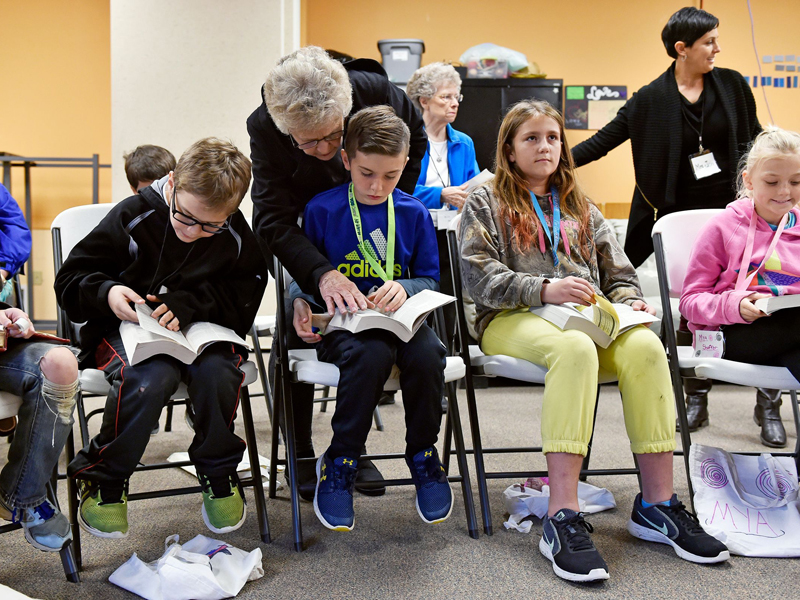YORK, Pa. (USA Today Network) — It’s 2:00 on a Thursday afternoon in November — a school day. Right on schedule,18 elementary school students come running: They’re heading to church.
They’re among more than 3,000 students in Pennsylvania who participate in a “released time” program run by Joy El Ministries.
“Released time” is a legal way for students to voluntarily receive religious education during the school week. It has to happen outside the school building. It’s limited to 36 hours per school year by Pennsylvania law. Students need their parents’ approval. And they need to make up any work they miss.
Joy El’s program started in Franklin County, and has grown to 27 school districts in nine counties. They offer programs for students in grades 3 through 8 and are among several organizations that offer released time programs in Pennsylvania.
At one elementary school in Fulton County, participation rates among students have been as high as 100%, said Aaron Ziebarth, executive director of Joy El.
The volunteers at Kreutz Creek Elementary School’s program had a more modest crowd as they met in York County that Thursday afternoon. But it’s still a mission of love to them.
”It’s just wonderful to see them memorize God’s word and be excited by it,” said Pat Eyler, who has volunteered with the program at various times over the past 20 years. She said she became a Christian at a similar program, back in 1951.
Joy El was founded in 1938, back when the Bible was still allowed in school, according to Ziebarth.
Today, that’s not the case.
And volunteer Barry Jennings, says society has suffered.
At a recent Bible study he attended, the group reflected on the state of the world: “We were talking about things, like Charlottesville …. and then the hurricanes and … the borders and everything else. I think the main thing is … God’s trying to show us, we need to come back to him.”
Ziebarth tells a similar tale. He sees bad news all around and believes the released time program will point students towards faith: “I just believe that life is hopeless without Jesus.”
Today, over half of the students who attend a Joy El released time program are un-churched, according to Ziebarth. They attend a program with three primary components: Singing, teaching and listening — small group time.
Some come primarily to learn. Some follow friends. Some, admittedly, come to get out of school, said Ziebarth.
But regardless of their motives, he’s says they’ll benefit from being there — in this life or the next.
Practically, he claims that the individualized attention and mentorship helps the students academically — the group averages one volunteer for every 2.4 students, he said.
And even if that weren’t the case, he thinks the one hour of instruction missed per week is a small price to pay for the religious education the students receive.
“First of all, I have a bigger picture, longer view than just life on earth. I believe we need to be preparing for what’s beyond. And of course, released time helps to do that.”
‘The law is pretty settled’
When the American Civil Liberties Union has concerns about released time programs, they usually fall into one of two categories, said Sara Rose, a senior staff attorney for the ACLU of Pennsylvania:
Are schools using resources to promote the program? And are the students who choose not to participate still receiving adequate instruction?
Joy El knows that schools shouldn’t use resources on the program — not the school building, not transportation, not promotion. “Neutral” is a word that Ziebarth used to describe how schools should treat released time.
But if a released time program becomes popular enough that a majority of students attend, the school is still obligated to educate the students who remain, Rose said.
Ziebarth says some school districts have concerns about lost instruction time, but from the ACLU’s perspective, that’s not a pressing legal concern.
”Schools release kids to do all kinds of things during the day,” Rose commented. From a legal perspective, it can be problematic to release a student from school for gymnastics but not for religious education.
The legal framework for released time programs has been decided in a series of court cases, but individual states enact laws to allow for released time programs in their state, said Rose.
Ziebarth said that he’s aware of 15 states with released time programs, which, he notes, aren’t limited to Christian education.
‘Under the radar’
Since school districts can’t promote the program, awareness is sometimes a struggle for Joy El.
“It kinda flies under the radar, in some ways,” said Ziebarth. There’s so many things for people to talk about, this doesn’t always get a lot of press. Legally, schools cannot endorse it or oppose it. … So what that means is a lot of times there’s not a whole lot of information given about it.”
Often students hear about the program from friends. Then, they’re left to navigate the proper paperwork and parental consent with the school district and the released time program.





